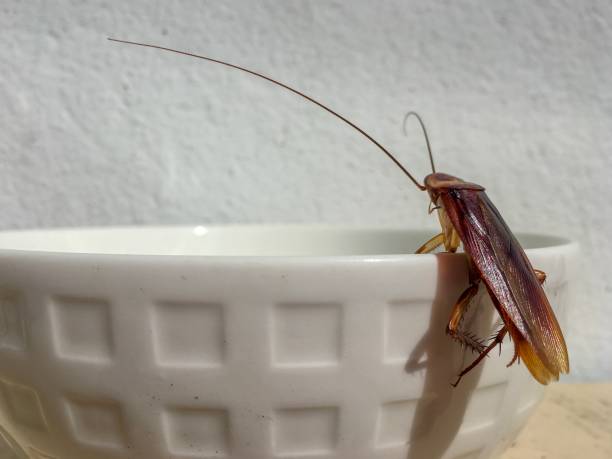Flying cockroaches are more than just a nuisance—they can invade your home, contaminate food, and trigger allergic reactions. Their ability to fly makes them particularly unsettling, as they can appear unexpectedly and cause panic. While not all cockroach species can fly, those that do are often more difficult to eliminate because they can reach places that crawling roaches cannot. Whether you’re dealing with American cockroaches, which are known for their flying abilities, or another species, knowing how to get rid of flying cockroaches is essential for maintaining a clean and safe home.
In this comprehensive guide, we will explore the best methods for eliminating flying cockroaches, including natural remedies, chemical solutions, and preventive strategies.
What Are Flying Cockroaches?
Flying cockroaches are a subset of roach species that have fully developed wings and can use them to glide or fly short distances. While not all cockroaches can fly, some species—like the American cockroach, Australian cockroach, and Asian cockroach—have the ability to take flight, especially when they are disturbed or trying to escape.
It’s important to note that even flying cockroaches are not strong fliers. They usually use their wings to glide down from elevated surfaces, rather than flying long distances like birds or insects such as flies and mosquitoes.
Why Are Flying Cockroaches a Problem?
Like their non-flying relatives, flying cockroaches are a health hazard. They can carry pathogens on their bodies, spread bacteria, and contaminate food. Here are some key reasons why flying cockroaches are a problem:
- Allergies and Asthma: Cockroach droppings, saliva, and shedding body parts can trigger allergic reactions in some people and exacerbate asthma symptoms.
- Food Contamination: Cockroaches are known to spread harmful bacteria such as E. coli and Salmonella, which can contaminate food and kitchen surfaces.
- Unpleasant Odor: Cockroaches emit a foul-smelling odor, especially in larger infestations. This smell can linger in your home if not addressed.
- Rapid Reproduction: Cockroaches reproduce quickly, making it difficult to control an infestation once it starts. A few cockroaches can turn into hundreds in a short time.
Now that we understand the problem, let’s dive into how to effectively get rid of flying cockroaches.
How to Get Rid of Flying Cockroaches: Natural Methods
For those who prefer to avoid chemical pesticides, there are several natural methods to help you get rid of flying cockroaches. These methods are eco-friendly, safe for pets and children, and can be highly effective when used correctly.
1. Use Essential Oils
Cockroaches are repelled by the strong scent of certain essential oils. Peppermint oil, tea tree oil, and eucalyptus oil are especially effective at driving away cockroaches. Here’s how to use them:
- Mix 10-15 drops of essential oil with water in a spray bottle.
- Spray the mixture in areas where cockroaches are likely to enter, such as kitchen cabinets, sinks, and windowsills.
- Repeat the process daily until you no longer see any roaches.
2. Diatomaceous Earth
Diatomaceous earth is a natural, non-toxic powder made from fossilized remains of tiny aquatic organisms. When cockroaches come into contact with diatomaceous earth, it dehydrates their exoskeletons, eventually killing them.
- Sprinkle food-grade diatomaceous earth in areas where you’ve seen cockroach activity, such as cracks, corners, and under appliances.
- The powder should be left undisturbed for several days. It is safe for humans and pets, but harmful to cockroaches.
- After a week, vacuum up the powder and replace it if necessary.
3. Baking Soda and Sugar
One of the most popular DIY cockroach traps involves baking soda and sugar. Baking soda is toxic to cockroaches, while sugar acts as bait to lure them in.
- Mix equal parts of baking soda and sugar in a bowl.
- Sprinkle the mixture near roach-infested areas, such as the kitchen or bathroom.
- Once the cockroaches consume the mixture, the baking soda reacts with their stomach acid, causing them to die.
4. Boric Acid
Boric acid is a tried-and-true method for killing cockroaches. It’s a naturally occurring compound that is lethal to cockroaches when ingested.
- Dust a thin layer of boric acid in places where cockroaches are likely to walk, such as under sinks, behind appliances, and along baseboards.
- When cockroaches come into contact with the powder, they will carry it back to their nest, helping to kill other roaches in the colony.
Chemical Solutions for Flying Cockroach Infestations
For larger infestations or when natural methods aren’t enough, chemical solutions can help eliminate flying cockroaches quickly and effectively. Here are some of the best chemical options:
1. Cockroach Gel Bait
Cockroach gel bait is one of the most effective ways to control a cockroach infestation. The gel contains a slow-acting poison that cockroaches ingest and bring back to their colony.
- Apply small dots of gel bait in areas where roaches are active, such as under cabinets, around baseboards, and in cracks and crevices.
- The roaches will consume the bait and return to their nest, where the poison will spread to other roaches, killing the entire colony.
2. Insecticide Sprays
Insecticide sprays are a quick and convenient way to kill flying cockroaches on contact. Many commercial sprays are available that target both crawling and flying insects.
- Spray directly on cockroaches whenever you see them. This provides immediate results by killing the roaches instantly.
- Be cautious when using sprays around food preparation areas, and follow the instructions on the label carefully.
3. Cockroach Traps
Sticky cockroach traps can be placed around your home to capture cockroaches. These traps are non-toxic and easy to use.
- Place traps in areas with high cockroach activity, such as the kitchen, bathroom, and near garbage cans.
- Check the traps regularly and dispose of them once they are full of cockroaches.
How to Prevent Flying Cockroach Infestations
Preventing flying cockroaches from entering your home is just as important as getting rid of them. By following these preventive measures, you can significantly reduce the chances of a cockroach infestation.
1. Seal Entry Points
Cockroaches can enter your home through cracks, gaps, and open windows. Inspect your home for potential entry points and seal them using caulk or weather stripping.
- Seal cracks in walls, doors, and windows.
- Install door sweeps to prevent roaches from entering through gaps under doors.
- Repair any damaged window screens to keep flying cockroaches from getting inside.
2. Eliminate Food Sources
Cockroaches are attracted to food, so keeping your home clean and free of food debris is essential. Here’s how to eliminate their food sources:
- Clean up crumbs and spills immediately.
- Store food in airtight containers, especially in the pantry.
- Take out the trash regularly and keep garbage cans sealed.
3. Reduce Moisture
Cockroaches thrive in moist environments, so eliminating excess moisture in your home can deter them from settling in.
- Fix leaking pipes, faucets, and appliances.
- Use dehumidifiers in damp areas like basements and bathrooms.
- Wipe down sinks and bathtubs to remove standing water.
4. Regular Cleaning
Maintaining a clean home is one of the most effective ways to prevent a cockroach infestation. Regularly cleaning high-risk areas, such as the kitchen and bathroom, will keep cockroaches from finding food, water, or shelter.
- Sweep and mop floors regularly to remove food particles.
- Clean kitchen countertops and stovetops to eliminate grease and crumbs.
- Regularly clean behind and under appliances where cockroaches may hide.
Professional Pest Control: When to Call an Expert
If you’ve tried DIY methods and the cockroach problem persists, it may be time to call in professional pest control. A licensed exterminator can assess the situation and implement more advanced methods to eliminate flying cockroaches from your home.
- Pest Control Inspection: A professional will conduct a thorough inspection of your home to determine the source of the infestation and the best treatment plan.
- Advanced Treatment Options: Professionals may use more potent pesticides, fogging treatments, or heat treatments to eliminate cockroaches in hard-to-reach places.
- Ongoing Prevention Plans: Many pest control companies offer ongoing maintenance plans to keep your home roach-free in the long term.
FAQs
1. What attracts flying cockroaches to my home?
Ans – Flying cockroaches are attracted to food, water, and shelter. They often enter homes in search of these necessities, especially if they find open garbage, food crumbs, or standing water.
2. Are flying cockroaches dangerous?
Ans – While flying cockroaches are not directly harmful, they can spread bacteria, contaminate food, and trigger allergies or asthma in sensitive individuals.
3. Can I use natural methods to get rid of flying cockroaches?
Ans – Yes, there are several natural methods to eliminate flying cockroaches, including using essential oils, diatomaceous earth, and baking soda. These methods are effective for small infestations.
4. How long does it take to get rid of flying cockroaches?
Ans – The time it takes to eliminate flying cockroaches depends on the size of the infestation and the methods used. With proper treatment, you can start seeing results within a few days to a few weeks.
5. Can flying cockroaches come through windows?
Ans – Yes, flying cockroaches can enter your home through open windows or damaged window screens. It’s important to repair any broken screens and close windows, especially at night when roaches are more active.
6. How can I prevent cockroaches from coming back after treatment?
Ans – To prevent flying cockroaches from returning, seal entry points, eliminate food and water sources, and maintain a clean home. Regular pest control inspections can also help keep your home cockroach-free.
Conclusion
Flying cockroaches are more than just a nuisance—they pose serious health risks and can lead to a full-blown infestation if left unchecked. By following the natural and chemical methods outlined in this guide, you can get rid of flying cockroaches and prevent them from coming back. Whether you choose DIY solutions or professional pest control, the key to success is persistence, cleanliness, and proactive prevention. With the right approach, you can keep your home cockroach-free and safe for your family.



